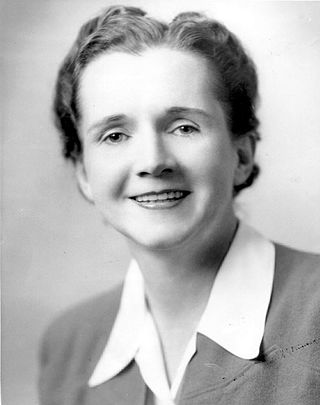
Rachel Louise Carson was an American marine biologist, writer, and conservationist whose influential book Silent Spring (1962) and other writings are credited with advancing the global environmental movement.

The peregrine falcon, also known as the peregrine, and historically as the duck hawk in North America, is a cosmopolitan bird of prey (raptor) in the family Falconidae. A large, crow-sized falcon, it has a blue-grey back, barred white underparts, and a black head. The peregrine is renowned for its speed, reaching over 320 km/h (200 mph) during its characteristic hunting stoop, making it the fastest bird in the world, as well as the fastest member of the animal kingdom. According to a National Geographic TV program, the highest measured speed of a peregrine falcon is 389 km/h (242 mph). As is typical for bird-eating raptors, peregrine falcons are sexually dimorphic, with females being considerably larger than males.

Falconry is the hunting of wild animals in their natural state and habitat by means of a trained bird of prey. Small animals are hunted; squirrels and rabbits often fall prey to these birds. Two traditional terms are used to describe a person involved in falconry: a "falconer" flies a falcon; an "austringer" flies a hawk or an eagle. In modern falconry, the red-tailed hawk, Harris's hawk, and the peregrine falcon are some of the more commonly used birds of prey. The practice of hunting with a conditioned falconry bird is also called "hawking" or "gamehawking", although the words hawking and hawker have become used so much to refer to petty traveling traders, that the terms "falconer" and "falconry" now apply to most use of trained birds of prey to catch game. Many contemporary practitioners still use these words in their original meaning, however.

The prairie falcon is a medium-large sized falcon of western North America. It is about the size of a peregrine falcon or a crow, with an average length of 40 cm (16 in), wingspan of approximately 1 meter (40 in), and average weight of 720 g (1.6 lb). As in all falcons, females are noticeably bigger than males. Though a separate species from the peregrine, the prairie falcon is basically an arid environment adaptation of the early peregrine falcon lineage, able to subsist on less food than the peregrine, and generally lighter in weight than a peregrine of similar wing span. Having evolved in a harsh desert environment with low prey density, the prairie falcon has developed into an aggressive and opportunistic hunter of a wide range of both mammal and bird prey. It will regularly take prey from the size of sparrows to approximately its own weight, and occasionally much larger. It is the only larger falcon native only to North America. It is resident from southern Canada, through western United States, and into northern Mexico. The prairie falcon is popular as a falconry bird, where with proper training it is regarded as being as effective as the more well known peregrine falcon.
Derek Almey Ratcliffe was one of the most significant British nature conservationists of the 20th century. He was Chief Scientist for the Nature Conservancy Council at the Monks Wood Experimental Station, Abbots Ripton, Huntingdon, retiring in 1989. Ratcliffe was the author of the 1977 Nature Conservation Review, a document which set out the most important sites for nature conservation in the United Kingdom. He also published various works on nature and conservation.
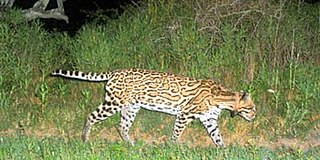
Laguna Atascosa National Wildlife Refuge is the largest protected area of natural habitat left in the Lower Rio Grande Valley. The 98,000-acre (400 km2) refuge is located almost entirely in Cameron County, Texas, although a very small part of its northernmost point extends into southern Willacy County.
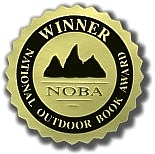
The National Outdoor Book Award (NOBA) was formed in 1997 as an American-based non-profit program which each year presents awards honoring the best in outdoor writing and publishing. It is housed at Idaho State University and chaired by Ron Watters. It is sponsored by the National Outdoor Book Awards Foundation, Idaho State University and the Association of Outdoor Recreation and Education. As of 2021, awards have been presented in 13 categories, although not all categories are awarded in any given year.

Red Rock Lakes National Wildlife Refuge is a remote refuge located in the high elevation of the Centennial Valley, in the southwestern region of the U.S. state of Montana. Adjacent to Gallatin National Forest and near Yellowstone National Park, the refuge is an integral part of the Greater Yellowstone Ecosystem. Red Rock Lakes is best known for being the primary location for the efforts saving the trumpeter swan from extinction, which by 1932 had fewer than 200 known specimens in the United States and Canada. By the year 2002, an estimated 3,000 trumpeters were wintering on the refuge, many having migrated south from their summer range in Canada. The trumpeters are now so plentiful that efforts are being undertaken to help them reestablish historical migratory routes to areas further south in the Rocky Mountains and the Great Basin region. The elegant trumpeter swan is North America's largest waterfowl, with a wingspans of 8 feet and they can weigh up to 30 pounds (13 kg).
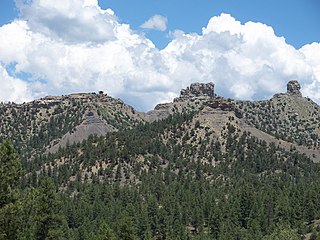
Chimney Rock National Monument is a 4,726-acre (1,913 ha) U.S. National Monument in San Juan National Forest in southwestern Colorado which includes an archaeological site. This area is located in Archuleta County, Colorado, between Durango and Pagosa Springs, and is managed for archaeological protection, public interpretation, and education. The Chimney Rock Archaeological Site has been listed on the National Register of Historic Places since 1970. U.S. President Barack Obama created Chimney Rock National Monument by proclamation on September 21, 2012 under authority of the Antiquities Act.

The Mauritius kestrel is a bird of prey from the family Falconidae endemic to the forests of Mauritius, where it is restricted to the southwestern plateau's forests, cliffs, and ravines. It is the most distinct of the Indian Ocean kestrels. It colonized its island home to evolve into a distinct species probably during the Gelasian . It is the most distant living species among the western Indian Ocean kestrels.
Hacking is a training method that helps young birds of prey reach their hunting potential by giving them exercise and experience. This technique is used to prepare the falcon to become an independent hunter. The sequence of the procedure includes captivity, releasing, flight, and either the falcon will be recaptured for falconry or released into the wild. This has also been adapted to other raptor species to preserve the population. Generally, falconers agree that hacked falcons are better and more preferred in the field. Hacking is beneficial, not only for the falconers, but for the bird itself and the species; however, there are some criticism and restrictions that come along with this method.
The Oregon Book Awards are presented annually by Literary Arts to honor the "state’s finest accomplishments by Oregon writers who work in genres of poetry, fiction, graphic literature, drama, literary nonfiction, and literature for young readers."
The Peregrine Fund is a non-profit organization founded in 1970 that conserves threatened and endangered birds of prey worldwide. The successful recovery of the peregrine falcon in the United States, which was removed from the U.S. Endangered Species List in 1999, enabled the organization to expand its mission to include other endangered raptors around the world. The Peregrine Fund is headquartered at its World Center for Birds of Prey in Boise, Idaho, on a 580-acre (2.3 km2) campus with breeding and research facilities, an administrative office, interpretive center, research library, and archives.
Buckaringa Sanctuary is a 20 km2 nature reserve in the southern Flinders Ranges of South Australia. It is 30 km north of the town of Quorn. It is owned and managed by the Australian Wildlife Conservancy (AWC).
Arizona Beach State Recreation Site is a 68-acre (28 ha) Oregon state park in Curry County, Oregon, in the United States. The beach is at an average elevation of 7 feet (2 m). Public recreational facilities at Arizona Beach State Recreation Site include a parking lot for beach access, observation areas for viewing marine mammals and birds and tables for picnicking. The park is open year-round.

The ecology of the Rocky Mountains is diverse due to the effects of a variety of environmental factors. The Rocky Mountains are the major mountain range in western North America, running from the far north of British Columbia in Canada to New Mexico in the southwestern United States, climbing from the Great Plains at or below 1,800 feet (550 m) to peaks of over 14,000 feet (4,300 m). Temperature and rainfall varies greatly also and thus the Rockies are home to a mixture of habitats including the alpine, subalpine and boreal habitats of the Northern Rocky Mountains in British Columbia and Alberta, the coniferous forests of Montana and Idaho, the wetlands and prairie where the Rockies meet the plains, a different mix of conifers on the Yellowstone Plateau in Wyoming and in the high Rockies of Colorado and New Mexico, and finally the alpine tundra of the highest elevations.
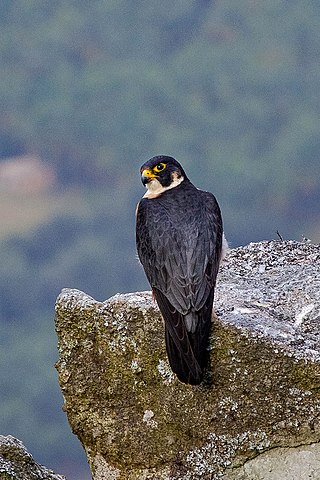
The shaheen falcon is a non-migratory subspecies of the peregrine falcon found mainly in the Indian subcontinent. It has also been described as a migratory subspecies. Other common names for the subspecies include the black shaheen and Indian peregrine falcon. The word shaheen in these names may also be spelled as shahin. This species was termed as the black shaheen by falconers to separate it from the true shaheen of Persian literature. Scholars of Persian and the Russian ornithologist Georgi Petrovich Dementiev have noted that the name shaheen in Persian literature actually referred to Falco peregrinus babylonicus.
Marcy Cottrell Houle is an American writer and wildlife biologist. She lives in Portland, Oregon.
Roland Charles Clement was an American environmentalist who worked for two decades at the National Audubon Society where he served many roles including staff biologist, staff ecologist, and Vice President. He was also a key figure in helping to ban DDT.

The Prairie Keepers: Secrets of the Zumwalt is a book by American wildlife biologist Marcy Cottrell Houle. Originally published in 1995, the book documents Houle's experience studying the unusually prevalent amount of raptors on the Zumwalt Prairie while researching for Oregon State University with a grant from the U.S. Fish and Wildlife Service in 1979.














